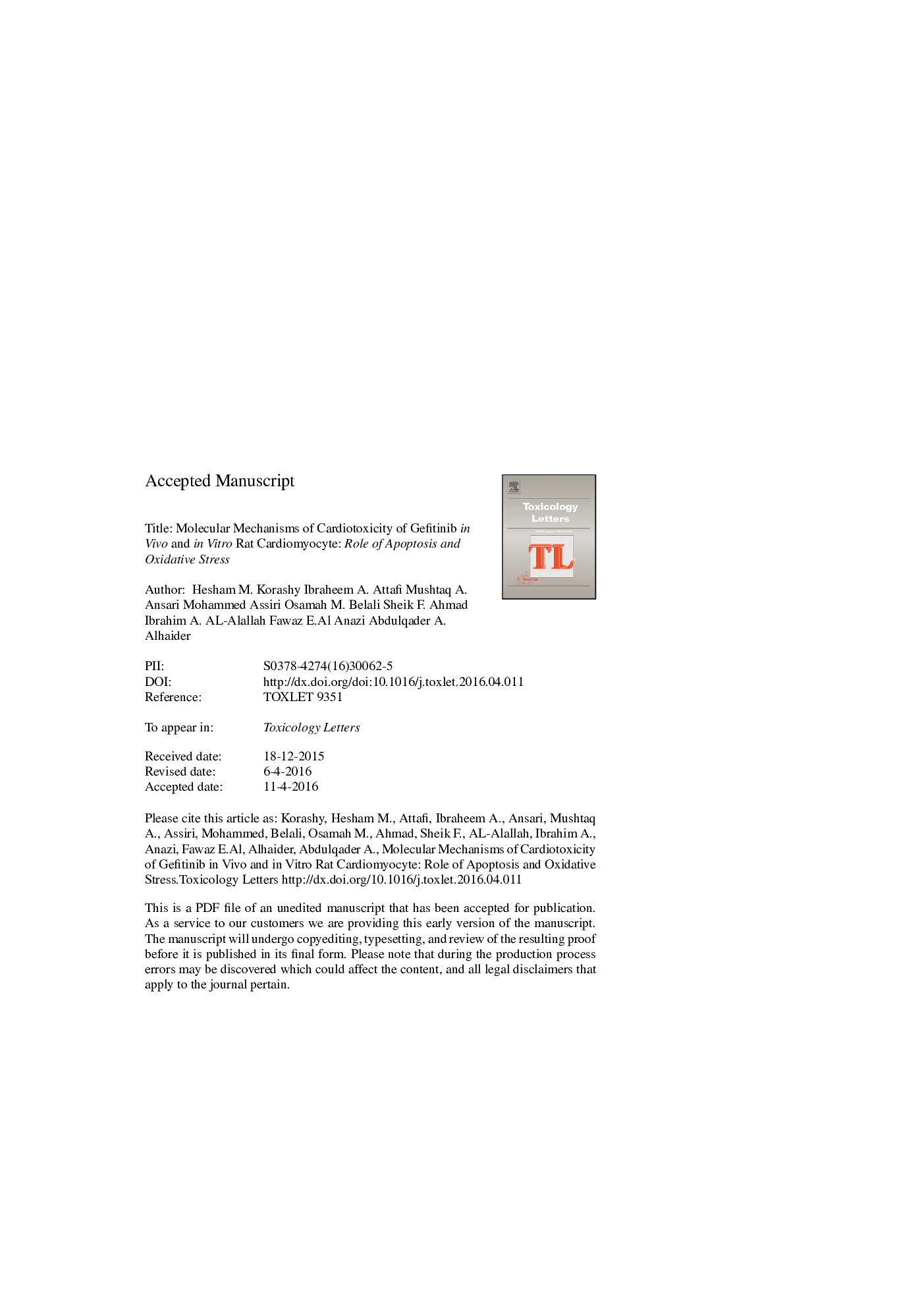| کد مقاله | کد نشریه | سال انتشار | مقاله انگلیسی | نسخه تمام متن |
|---|---|---|---|---|
| 5859790 | 1562621 | 2016 | 38 صفحه PDF | دانلود رایگان |
عنوان انگلیسی مقاله ISI
Molecular mechanisms of cardiotoxicity of gefitinib in vivo and in vitro rat cardiomyocyte: Role of apoptosis and oxidative stress
دانلود مقاله + سفارش ترجمه
دانلود مقاله ISI انگلیسی
رایگان برای ایرانیان
کلمات کلیدی
موضوعات مرتبط
علوم زیستی و بیوفناوری
علوم محیط زیست
بهداشت، سم شناسی و جهش زایی
پیش نمایش صفحه اول مقاله

چکیده انگلیسی
Gefitinib (GEF) is a multi-targeted tyrosine kinase inhibitor with anti-cancer properties, yet few cases of cardiotoxicity has been reported as a significant side effect associated with GEF treatment. The main purpose of this study was to investigate the potential cardiotoxic effect of GEF and the possible mechanisms involved using in vivo and in vitro rat cardiomyocyte model. Treatment of rat cardiomyocyte H9c2 cell line with GEF (0, 1, 5, and 10 μM) caused cardiomyocyte death and upregulation of hypertrophic gene markers, such as brain natriuretic peptides (BNP) and Beta-myosin heavy chain (β-MHC) in a concentration-dependent manner at the mRNA and protein levels associated with an increase in the percentage of hypertrophied cardiac cells. Mechanistically, GEF treatment caused proportional and concentration-dependent increases in the mRNA and protein expression levels of apoptotic markers caspase-3 and p53 which was accompanied with marked increases in the percentage of H9c2 cells underwent apoptosis/necrosis as compared to control. In addition, oxidative stress marker (heme oxygenase-1, HO-1) and the formation of reactive oxygen species were increased in response to GEF treatment. At the in vivo level, treatment of Wistar albino rats for 21 days with GEF (20 and 30 mg/kg) significantly increased the cardiac enzymes (CK, CKmb, and LDH) levels associated with histopathological changes indicative of cardiotoxicity. Similarly, in vivo GEF treatment increased the mRNA and protein levels of BNP and β-MHC whereas inhibited the antihypertrophoic gene (α-MHC) associated with increased the percentage of hypertrophied cells. Furthermore, the mRNA and protein expression levels of caspase-3, p53, and HO-1 genes and the percentage of apoptotic cells were significantly increased by GEF treatment, which was more pronounced at the 30 mg/kg dose. In conclusion, GEF induces cardiotoxicity and cardiac hypertrophy in vivo and in vitro rat model through cardiac apoptotic cell death and oxidative stress pathways.
ناشر
Database: Elsevier - ScienceDirect (ساینس دایرکت)
Journal: Toxicology Letters - Volume 252, 11 June 2016, Pages 50-61
Journal: Toxicology Letters - Volume 252, 11 June 2016, Pages 50-61
نویسندگان
Hesham M. Korashy, Ibraheem M. Attafi, Mushtaq A. Ansari, Mohammed A. Assiri, Osamah M. Belali, Sheik F. Ahmad, Ibrahim A. AL-Alallah, Fawaz E.Al Anazi, Abdulqader A. Alhaider,